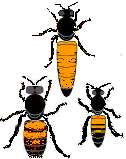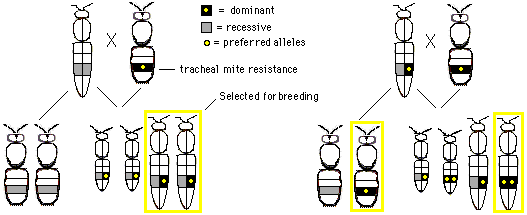Principles of Honeybee Genetics
 Use this page as a tool for visualizing and understanding some of the various genetic mechanisms at work in honeybees.
Use this page as a tool for visualizing and understanding some of the various genetic mechanisms at work in honeybees.- Mating behavior - multiple mates make for a complex family.
- Chromosome number - key in understanding bee genetics.
- Cordovan color- a useful genetic marker, controlled by a recessive gene.
- Hygienic behavior: two recessive genes for uncapping and removing diseased brood.
- Tracheal mite resistance - thought to be controlled by dominant gene(s).
- Sex alleles - determines solid or scattered brood pattern.
- Mitochondrial DNA - used to trace the maternal lineage of bees.
- Oddball bees - a gallery of unusual bees.
- Principles of honey bee genetics - adapted from an EAS workshop


To keep things simple, further examples will show a queen mated to a single drone.
This can be done with instrumental insemination, to sort genetic traits.

- Drones result from unfertilized eggs (parthenogenesis).They have no father.
- All eggs and sperm carry 16 chromosomes each.
- Each egg contains a unique combination of 50% of the queens genes.
- All 10 million sperm produced by a drone are identical clones.
- Since each queen mates with 10-20 drones, colonies are comprised of subfamilies, each having the same mother but different fathers.
- Workers of the same subfamily are related by 75% of their genes.
- This "extra" close relatedness may explain the cooperative, and altruistic behaviors found in colonies.
- It also explains why workers forego their own reproduction in favor of helping their queen mother raise more sisters. Their sisters are more closely related to them than their own offspring would be. (75% vs 50%)


Wild type Italian




Mitochondrial DNA

No comments:
Post a Comment